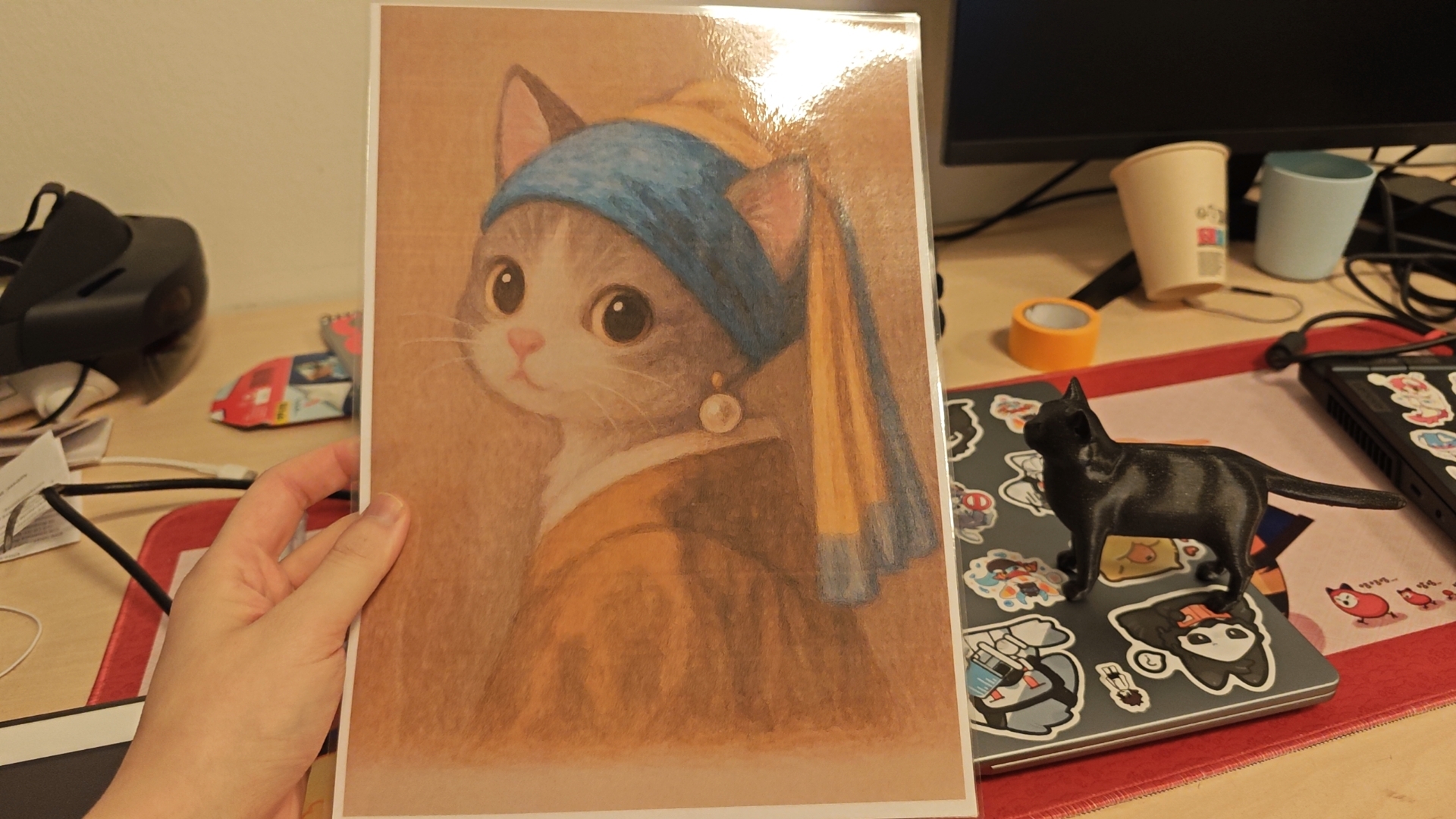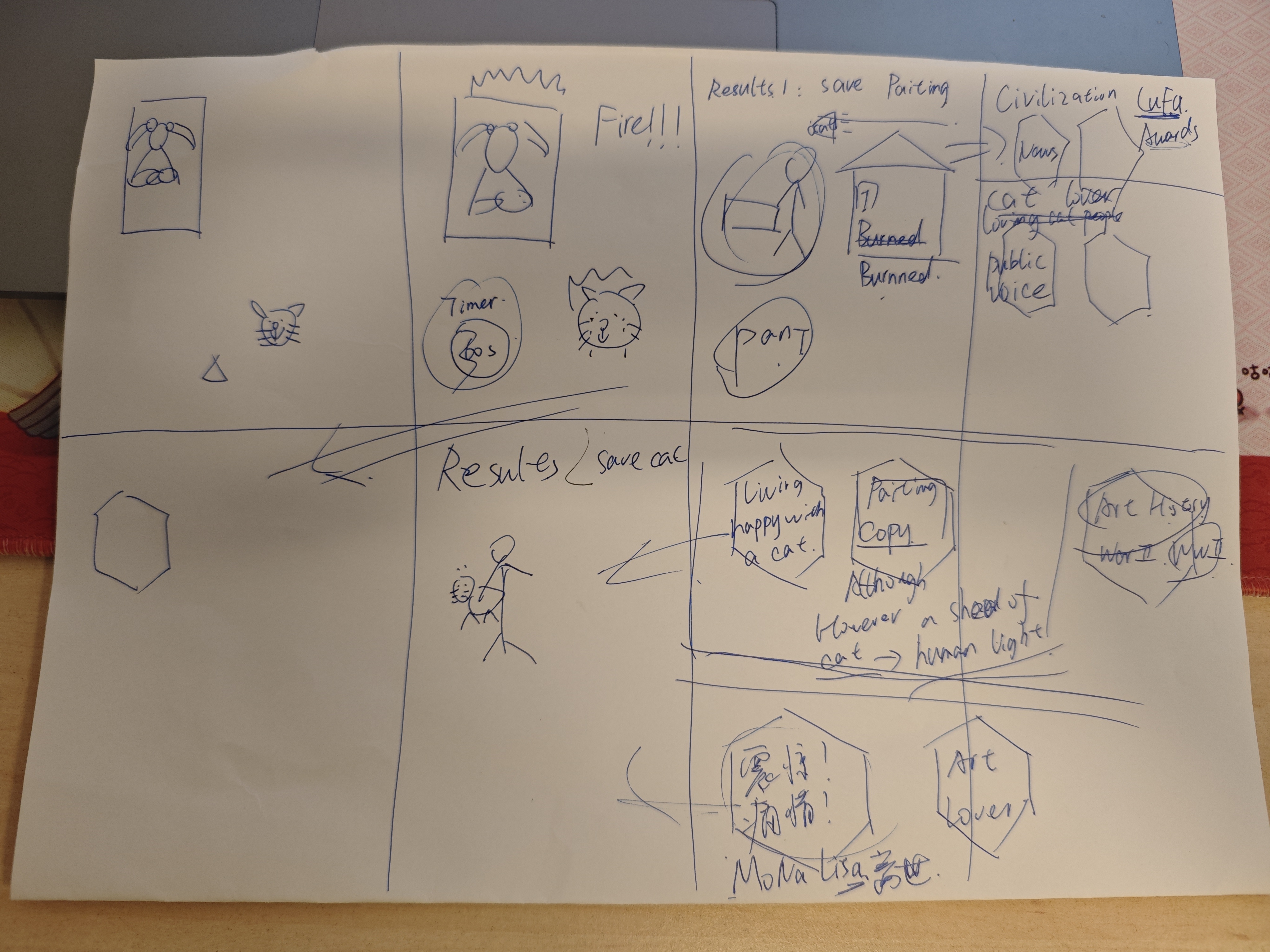Game Log 2 – Play
1. Play Methods
PLAY Methods: Describe your work using the PLAY Methods, the results of each method and provide documentation/visuals from the methods, as well as reflections on how this has changed and refined your game making process from the EXPERIENCE to the PLAY phase. What have you learned, what decisions have you made, and how have you progressed in your thinking?
🔹 1. Culture + Value + Game Collage

🧰 What We Did:
- Created a prototype capturing the emotional contrast between cultural legacy (the painting) and living vulnerability (the cat).
- Used classical art references, emotional imagery (fire, eyes, silence), and contrasting aesthetics to explore values like civilization vs. compassion, eternity vs. mortality, and rationality vs. instinct.
📈 Outcome:
- Helped solidify the mood and tone of the game world: soft, haunting, reflective.
- Anchored the philosophical dimension of the dilemma — not just "saving an object or a life" but the meaning of memory and responsibility.
🔹 2. 6-8-5 Game Sketching
🧰 What We Did:
- Sketched multiple variations of how the moral dilemma could play out in different settings.
- Explored different player perspectives: witness, rescuer, moral observer, etc.
📈 Outcome:
- Converged on the idea that AR in a familiar real-world setting (museum) creates stronger emotional tension than fully virtual worlds.
- Reinforced the idea that “realness” enhances ethical discomfort, which is key for this game’s impact.
🔹 3. Concept Convergence
🧰 What We Did:
- Brought together our early sketches, and gameplay mechanics.
- Refined the central choice: cat vs. painting.
- Reframed the "choice" as irreversible and emotionally loaded, supported by philosophical quotes and post-decision reflection.
📈 Outcome:
- Produced a clear, emotionally coherent concept anchored in cultural heritage, ethics, and empathy.
- Clarified our goals: not judgment, but emotional reflection.
🔹 4. Future Culture Worlds
🧰 What We Did:
- Imagined the post-decision world after the player chooses.
- Used visuals to portray two “future timelines”:
- Civilization celebrates you for saving culture
- The cat lives on — but the world mourns the painting
- The cat lives on — but the world mourns the painting
📈 Outcome:
- Created visuals that emotionally extend the player’s choice, even after gameplay ends.
- Defined how culture, memory, and narrative live beyond action.
✍️ Overall Reflections (EXPERIENCE → PLAY)
- We moved from an abstract ethical idea (like the trolley problem) to a deeply grounded, emotionally immersive experience.
- These methods helped us:
- Define our game's cultural identity
- Clarify the emotional goal (not solving — feeling)
- Shape the gameplay as a moral stage, not a puzzle
2. Games through Culture concept
Games through Culture concept: Conclude your Game Log 2 with a description of your Game through Culture concept highlighting how you are now nearer the cultural gameworld and empowering gameplay you are aiming for - and how your thinking and concept is stronger.
2.1 Cultural Gameworld
Ashes or Breath is no longer just a moral dilemma choice game, it has become a culturally reflective experience that invites players to confront the values they carry, the emotions they trust, and the weight of seemingly simple decisions.
Through this process, we’ve moved closer to building a cultural gameworld in three key ways:
- Cultural Heritage as Dilemma, Not Decoration Instead of using “culture” as a setting, we now frame it as the core ethical tension:
What does preserving a symbol of civilization mean if it costs a life? What do we value more, legacy or presence?
- Empowering Players Through Emotional Agency The game does not reward or punish decisions. Instead, it gives players ownership of their choices and the space to reflect on their emotional and cultural consequences. In this game, empowerment comes not from mastery but from meaning.
- A Gameworld That Thinks and Feels Our AR design and narrative world try to make culture come alive: the museum, the fire, the voiceover fragments, and the post-decision reflections all evoke a world where history, memory, and emotion are entangled. Players aren’t just making decisions, they’re navigating the values that define what it means to be human.
2.2 How Our Concept is Stronger Now
- We shifted from "a cool AR moral choice" to a philosophically loaded, culturally meaningful narrative space.
- We use AR not for spectacle, but for placing emotional stakes in the player's real world.
- Our design now focuses not just on what happens during the game, but on what remains after: the inner questioning, the doubt, the realization.
3. Expert Council Feedback
Expert Council Feedback: Document your feedback received from the expert council and your reflections on it. Summarise how you will work with the feedback and everything you have learned during the PLAY phase as you now move into the IMAGINE phase.
🔸 1. Make the Moral Choice More Balanced and Emotionally Difficult
Experts emphasized that the core dilemma, saving the cat or the painting, should feel truly difficult. Both choices must carry equally strong emotional and ethical weight so the player feels torn. This means enhancing narrative, emotional cues, and cultural value for both sides of the choice.
🔸 2. Increase Interactivity and Replay Value
The game should be compelling enough to replay, offering new emotional insights or narrative fragments with each run. This could involve:
- Dynamic consequences
- Optional paths or scenes
- Unlockable memories or reflective spaces
The goal is for players to want to come back, not to “win,” but to understand differently each time.
🔸 3. Draw from the Structure of the Trolley Problem
The classic philosophical dilemma was recommended as a design model. Key elements we’ll focus on:
- Action vs. inaction
- Abstract vs. personal value
- Sacrifice vs. protection
This will help us sharpen the moral clarity and ambiguity in a structurally sound way.
🔸 4. Make the Loss of the Painting Feel Deeper and More Devastating
When the player chooses to save the cat, the cultural loss must feel real and haunting. We will include:
- A digital news broadcast reporting the loss
- Emotional responses from historians or museum curators
- A dimmed, empty gallery space with echoes of what was lost
This ensures that the consequences are more than just implied. They’re felt.
🔸 5. Control Pacing — Let the Tension Build Slowly
Instead of rushing the player into the fire scenario, allow time to explore:
- Let them explore the gallery calmly
- Establish emotional attachment to both the painting and the cat
- Then, disrupt it gradually — making the transition from peace to panic more jarring and impactful
🔸 6. Strengthen Background and Worldbuilding
Include small but meaningful environmental storytelling:
- A plaque next to the painting
- A collar tag on the cat
- Museum audio guides or whispering reflections
These create subtle ways for players to connect with both sides of the dilemma.
🔸 7. Visualize the Consequences
Regardless of the choice, the outcome needs to be shown, not told:
- If the cat is lost: burn marks, echoing meows, memory fragments
- If the painting is lost: shattered glass, blank gallery walls, news clippings
Get Ashes or Breath
Ashes or Breath
| Status | Released |
| Authors | Ge Kacy Fu, Chengdong "Black" Sun, echolab27 |
More posts
- Game Log 4 – CreateMay 13, 2025
- Game Log 3 – MockupMay 13, 2025
- Game Log 1 – ExperienceMar 26, 2025


Leave a comment
Log in with itch.io to leave a comment.